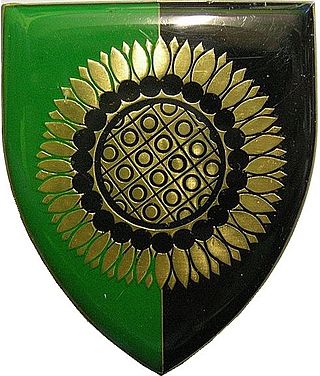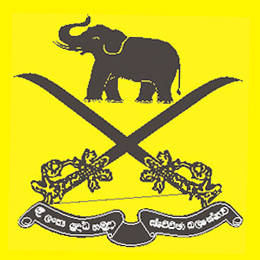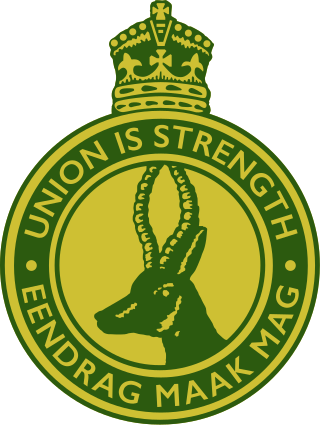
The South African Army is the principal land warfare force of South Africa, a part of the South African National Defence Force (SANDF), along with the South African Air Force, South African Navy and South African Military Health Service. The Army is commanded by the Chief of the Army, who is subordinate to the Chief of the SANDF.

The South African National Defence Force (SANDF) comprises the armed forces of South Africa. The commander of the SANDF is appointed by the President of South Africa from one of the armed services. They are in turn accountable to the Minister of Defence and Military Veterans of the Defence Department.
The South African National Defence Force's rank system is largely based on the British system, with the Air Force sharing the Army rank titles.

The South African Army Artillery Formation is the controlling entity of all South African Army artillery units. It draws much of its history from the South African Artillery, established in 1934 but with roots that reach back to 1921. The formation consists of both regular and reserve units. There is a separate South African Army Air Defence Artillery Formation that directs army anti-aircraft warfare units.

The South African Army Engineer Formation is the controlling entity of all South African Army military engineering units. The Formation is currently commanded by the General Officer Commanding (GOC); Brigadier General C. Buyse

The General Botha Regiment is a reserve infantry regiment of the South African Army. The Regiment was named after General Louis Botha, the first prime minister of South Africa.
The South African Medical Service (SAMS) was a branch of the South African Defence Force (SADF). In 1994 when the SADF was merged with various other military and armed resistance forces as part of the post-apartheid reforms the SAMS became the South African Military Health Service of the South African National Defence Force. The SAMS operated three hospitals, 1 Military Hospital in Pretoria, 2 Military Hospital in Cape Town, and 3 Military Hospital in Bloemfontein. It also had three specialist institutes; the Institute for Aviation Medicine, the Institute for Maritime Medicine, and the Military Psychological Institute.

The Sri Lanka Army Volunteer Force (SLAVF) is the active-duty volunteer reserve force of the Sri Lanka Army. The SLAVF is separate from the Regular Force which consists of personal who are professional soldiers and its Regular Reserve, which comprises personal who have a mobilization obligation following their service in the regular army. The SLAVF consists of the volunteer force and the volunteer reserve; administration and recruitment of reserve personal is carried out by the Volunteer Force Headquarters in Shalawa, Kosgama which is headed by the Commandant of the Volunteer Force. It has a current strength of about 55,000 personnel. The SLAVF was known as the Ceylon Volunteer Force from 1949 to 1972 and the Sri Lanka Volunteer Force from 1972 to 1985.

Between the two world wars, the supply and maintenance of all technical stores and equipment, including ammunition and guns, for the Union Defence Force, was the responsibility of the South African Ordnance Corps.
The 2nd South African Infantry Brigade was an infantry brigade of the army of the Union of South Africa during World War II. The Brigade formed part of the 1st South African Infantry Division and was formed on 13 August 1940. It served in East Africa and the Western Desert and was disbanded on 1 January 1943.
South Africa follows the British system of awarding battle honours to military units, to recognise the battles, theatres and campaigns in which they have fought with distinction.

The Union Defence Force (UDF) comprised the armed forces of South Africa from 1 July 1912, when the Defence Act took effect, two years after the creation of the Union of South Africa, until 1957 when it was reorganised and renamed the South African Defence Force (SADF).

The South African Army Training Formation is the controlling entity of all South African Army training units. The Formation was established in April 1999 and mandated to provide, maintain and sustain landward common training to the SA Army.

The South African Army Air Defence Artillery Formation is the controlling entity of all South African Army Air Defence Artillery units. This Formation consists of both regular and reserve units.

Western Province Command was a command of the South African Army.

7 South African Infantry Division was a formation of the South African Army, active from the 1960s to 1999.
This page details the South African Army order of battle in 1940, before and after the formation of expeditionary forces.

The South African Army Signal Formation is a formation/corps of the South African Army.












